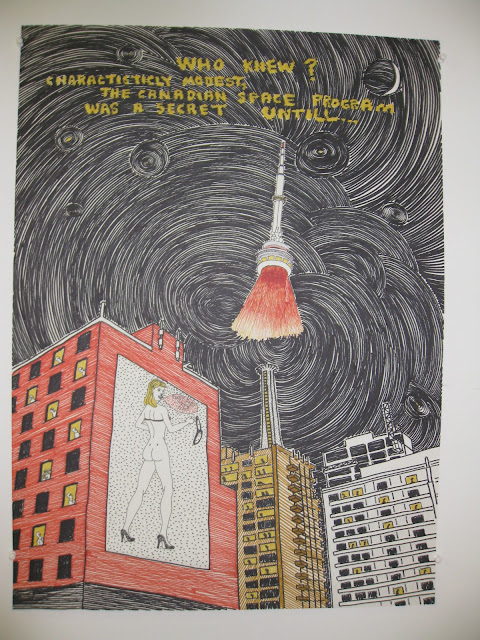I moved to Toronto in 2006 and set up my first studio at the corner of King and Bathurst. I wasn't sure what to do, so I spent a lot of time looking out the window, and thinking to myself, "What is it that makes Toronto, 'Toronto?'"
The CN Tower is the city's most iconic landmark, so I started making pictures of what it looks like from different neighborhoods. It's always looming in the sky, wherever you are in the city, like an aboriginal totem pole found on the West coast.
 |
| Original Drawing, 2007 (Digital Print Available) |
 |
| Woodblock Print, 2007 (Print Available, $300 each) |
 Woodblock Print 2007 (Print Available, $300 each)  Woodblock Print 2007 (Print Available, $300 each) |
 Original Drawing, 2007 (Digital Print Available) |
I wanted to show the CN Tower's special power, so I imagined it taking off.
 |
| Original Drawing, 2008 |
 |
| Silkscreen Poster, 2011 |

Silkscreen Poster, 2011
Silkscreen Poster, 2011
These posters can be purchased from me directly for $35 + HST plus shipping and handling by sending an email to rickoginzart@gmail.com
They can also be purchased framed for $100 + HST plus shipping and handling
Or, you can pick it up from my studio.
They can also be purchased at these locations:
Off The Wall Art and Custom Framing @ 450 Queen St. West
Beadle @ 1582 Dundas St. West
Birthia @ 1599 Dundas St. West
There's another visual aspect of Toronto, that I've come to enjoy--instead of looking up; looking down at the street scene. It's such a great city for walking, and the street cars are so wonderfully archaic, that they keep traffic moving at a walking pace. I imagine storefronts that evoke our desire, so I make up all sorts of things that are for sale.
 |
| Original Drawing, 2009 (Digital Print Available) |
 |
| Original Drawing, 2009 (Digital Print Available) |
 |
| Original Drawing, 2009 (Digital Print Available) |
Toronto has such an inferiority complex, that whenever I say, "I moved here from California," the response is always, "Why?" These images are my answer as to why I moved to Toronto.










































